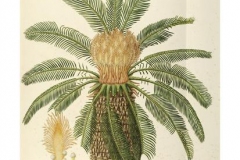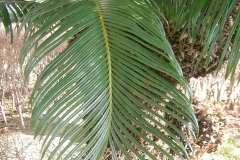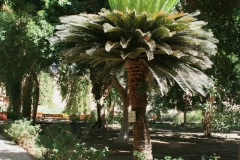Health Benefits of Sago Palm
- Weight gain
Sago is an inexpensive way to gain weight. 100 grams of serving provides 350 calories. It’s starchy substance which can be made into calorie dense puddings and shakes and offers energy to function normally and regain weight.
- Healthy Blood Pressure
Sago has small amount of potassium which helps to maintain healthy blood pressure. Potassium acts as a vasodilator which helps to relax tension in blood vessels. It lowers blood pressure and reduces overall strain on cardiovascular system.
- Digestive health
Sago is helpful for digestive issues and inflammation in stomach. The fiber content speed up digestive process and helps to rebalance the bacterial environment in the gut.
- Offers energy
Calories are the main source of energy for human beings which offer power for all processes. It helps to keep energy levels and regulated over course of the day.
- Bone mineral density
It has small content of iron, copper and calcium. It helps in creation of bone tissues that strengthen bone mineral density, prevent onset of osteoporosis and prevent inflammation throughout the body.
- Assist muscle growth
It has some compounds which assist speed recovery of muscle. The daily intake of sago helps the muscles to work for longer and fasten repair as well as growth.
- Neural Tube Defects
The moderate amounts of folic acid help to prevent the occurrence of neural tube defects in infants. The deficiency of this vitamin causes serious effects on pregnancy as well as new born. So adequate amount of folic acid is essential.
- Nerve health
Sago helps to promote the nervous system functions. Nervous system requires electrolytes to be balanced to effectively communicate messages from the brain to every part of the body including muscles.
- Promotes circulation
Sago has iron which is associated to red blood cells production in the body as well as circulation. It improves red blood cells, it promotes blood flower to extremities in the body that promotes healing and repair and boost energy levels.
Traditional uses
- It is used for treating rheumatism.
- In China, fruit is used to inhibit growth of tumors and leaves are used to treat cancer and hepatoma.
- Seeds and stems are used for treating high blood pressure, rheumatism, headaches, bone pain and congestion.
- The whole plant is used for indigestion, paralysis and snakebites in Bangladesh.
- It is used for painful urination in Assam.
Culinary uses
- Seeds are consumed raw or cooked.
- Dried seeds are grounded into powder and mixed with brown rice and fermented into date miso or sotetsu miso.
Precautions
- The daily intake of plant causes severe health problems and even death.
- The raw fruit causes headache, severe gastro-intestinal irritation such as nausea, stomach cramps, diarrhea and vomiting.
- Coma, liver damage and death are very few severe cases.
Other facts
- It is a slow growing plant which takes 50 years to attain full height.
- The plant produce large, cone like structures after 15 years of growth.
- The specimen of sago palm can live for 100 years.
References:
https://www.itis.gov/servlet/SingleRpt/SingleRpt?search_topic=TSN&search_value=183258#null
https://pfaf.org/user/Plant.aspx?LatinName=Cycas+revoluta
https://en.wikipedia.org/wiki/Cycas_revoluta
http://tropical.theferns.info/viewtropical.php?id=Cycas+revoluta
http://www.stuartxchange.org/Oliba.html
https://www.childrens.health.qld.gov.au/poisonous-plant-cycas-revoluta/
https://dengarden.com/landscaping/sago-palm-cycas-revoluta
https://ezinearticles.com/?Information-and-Facts-on-the-Sago-Palms&id=4774814
https://www.organicfacts.net/sago.html
Comments
| Sago Palm Quick Facts | |
|---|---|
| Name: | Sago Palm |
| Scientific Name: | Cycas revoluta Thunb |
| Origin | Southern Japanese islands of Kyushu, Ryukyu, Mitsuhama and Satsuma |
| Colors | Bright orange to red |
| Shapes | 2-3.5 cm long and 1.5-2.5cm wide |
| Name | Sago Palm |
|---|---|
| Scientific Name | Cycas revoluta Thunb |
| Native | Southern Japanese islands of Kyushu, Ryukyu, Mitsuhama and Satsuma |
| Common/English Name | False Sago, Sago Palm of Japan, Sago Palm, King Sago Palm, Sago Cycas, Sotetsu Nut, Sago cycad, Japanese sago palm, Cycad |
| Name in Other Languages | Burmese: Monmg-Tain; Chinese: Feng-Wei-Jiao-Yr, Su Tie (苏铁), Tie Shu, Liúqiú sūtiě (琉球苏铁); Czech: Cykas Japonský, Cykas Zavinutý; Danish: Japansk Cykas, Sagopalme, Tilbagerullet Sagotræ; Eastonian: Rahu-Palmlehik; Finnish: Saagopalmu; French: Cycas Sagoutier, Cycas Du Japon; German: Japanischer Sagobaum, Eingerollter Palmfarn, Japanischer Sagopalmfarn, Sagopalme; India: Madanagameswari (Tamil); Indonesia: Pakis Haji; Italian: Japan Sikasi, Palma A Sagù; Japan (Main Islands): Sotetsu, Ban Shou, Hou Bi, Hou Bi Shou, Sha Ka Shou, Tesshou, Tessio, Tosso; Japan (Ryuku Islands): Hichichi, Hitichi, Shichichi, Satetsu, Sichi, Sichidzi, Sidzidzui, Sidzichi, Sirichi, Sihittu, Sitechi, Sitidzi, Sitichi, Sitochi, Sitsudzu, Sitsuchi, Situchi, Susitykuki, Suidzu, Sutachi, Suticha, Sutta, Sutichi, Sutuku, Syutta, Suutichi, Syutto, Tsudzu (Plant), Kyungama, Nadzu, Mii, Nari, Sutitsi-Nari, Yanabu; Korea: So Ch’eol; Malaysia: Paku Laut; Philippines: Oliva (Spanish), Bait, Pitago Oliba (Tagalog); Russian: Sagovnik Ponikaiushchii, Sagovnik Ponikaiushchii Drevovidnyi (Trunk), Tsikas Ponikaiushchii; Spanish: Palma Sagú, Cicas Revoluta, Sagutero; Swedish: Kottepalm; Thai: Pron-Tha-Le; Turkey: Sago Hurma Ag; Vietnamese: Thuen Tú Ê |
| Soil | Well-drained |
| Plant Size | 7 m high |
| Leaf | 0.6-1.7m long, dark, olive green |
| Fruit shape & size | 2-3.5cm long and 1.5-2.5cm wide |
| Fruit color | Bright orange to red |





